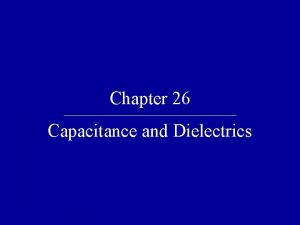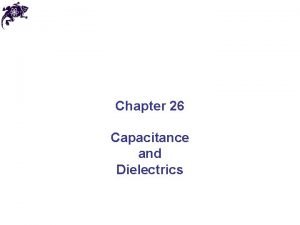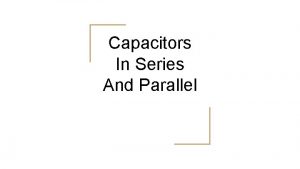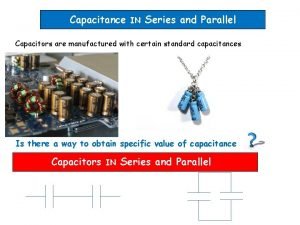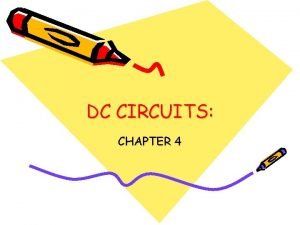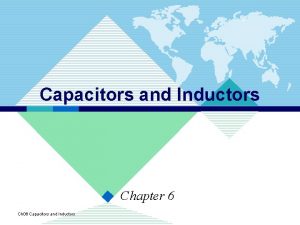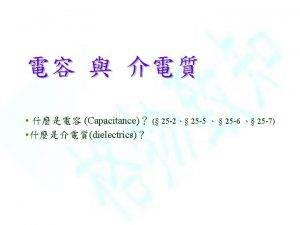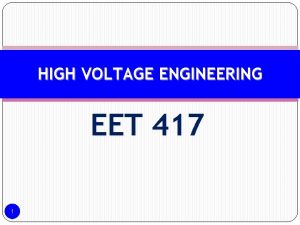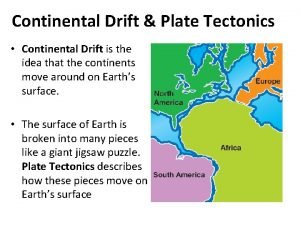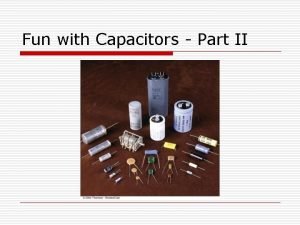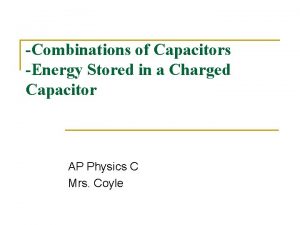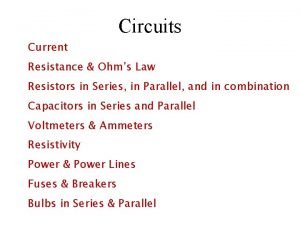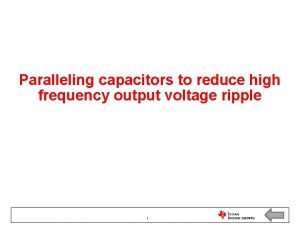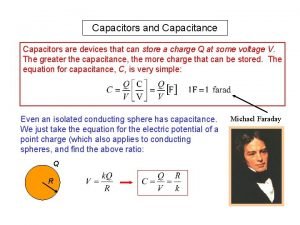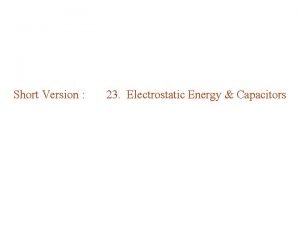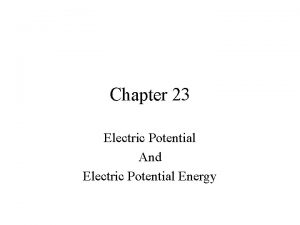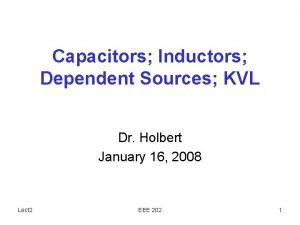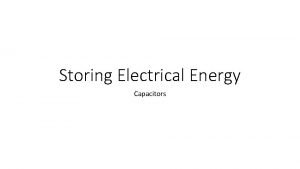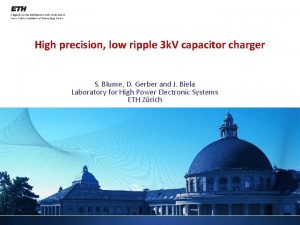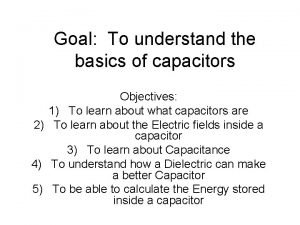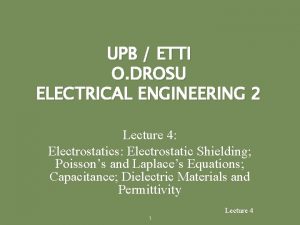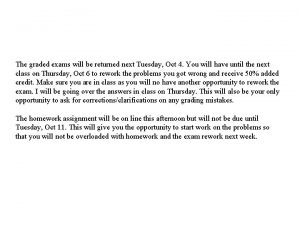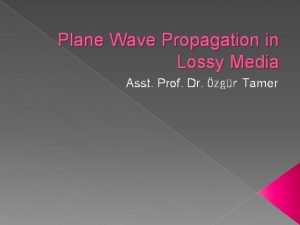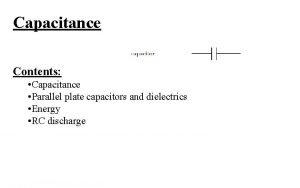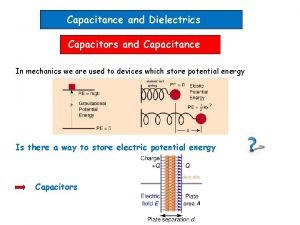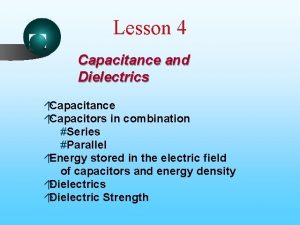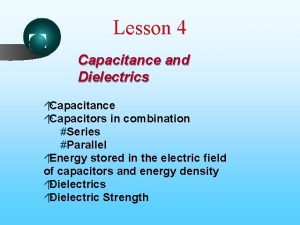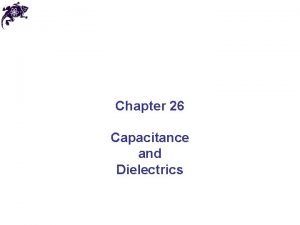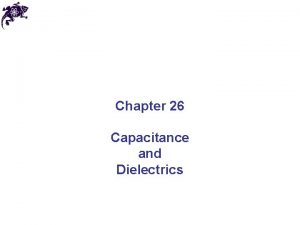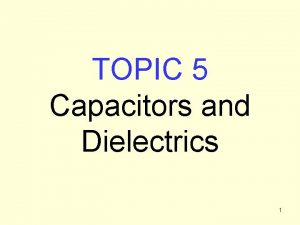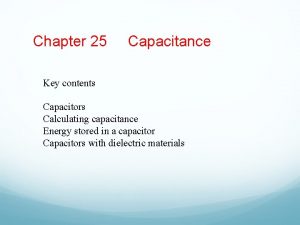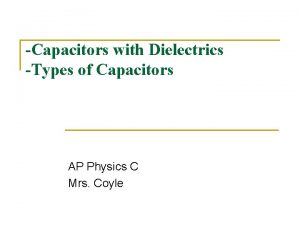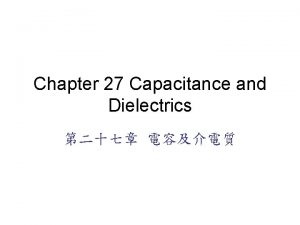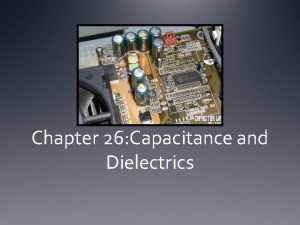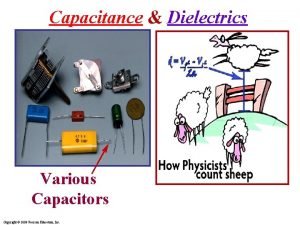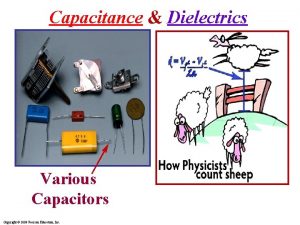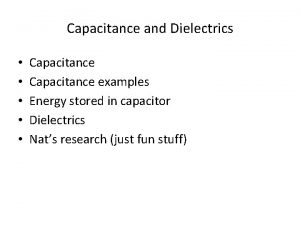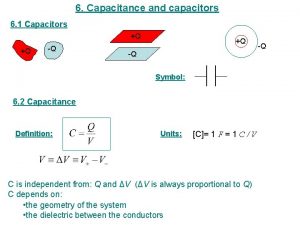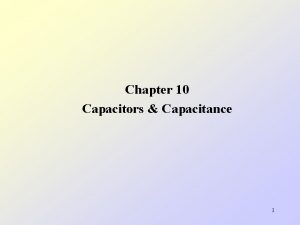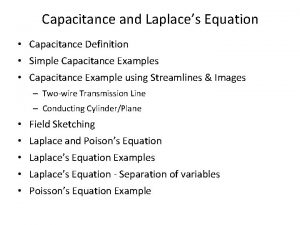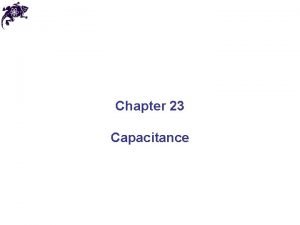Capacitance Contents Capacitance Parallel plate capacitors and dielectrics



























- Slides: 27

Capacitance Contents: • Capacitance • Parallel plate capacitors and dielectrics • Energy • RC discharge

Capacitance C = capacitance (Farads) q = Charge on the capacitor (C) V = voltage across the capacitor (V) demo big cap +++++++++++++++++++ - -------------------------------

µF = MFD = 10 -6 Farads, small ones are p. F = 10 -12 F

A CCD pixel has a capacitance of 1. 7 x 10 -12 F. What is the voltage across it if it has been charged 6. 0 x 104 electron charges? (1 e = 1. 602 E-19) V = q/C = (6. 0 E 11*1. 602 E-19/1. 7 E-16) = 5. 7 m. V

Whiteboards: Capacitance 1 -3

What is the charge on a 250 microfarad capacitor if it has been charged to 12 V? q = CV = (250 E-6 F)(12 V) = 3 E-3 Coulombs . 0030 C

What is the capacitance of a CCD pixel if it has. 014 V across it when it has a charge of 2. 13 x 10 -15 C? C = q/V = (2. 13 E-15 C)/(. 014 V) = 1. 52 x 10 -13 F 1. 5 x 10 -13 F (or 0. 15 p. F)

A 45 µF capacitor has 1. 2 µC of charge on it. What is the voltage across it? V = q/C = (2. 13 E-15 C)/(. 014 V) = 0. 02666…. 27 m. V

A = plate area (m 2) d = plate separation (m) ε = permittivity of dielectric (C 2 N-1 m-2) ε = Kεo (air ≈ εo = 8. 85 x 10 -12 C 2 N-1 m-2) Demo – different caps, and take apart cap with vdg


A variable Capacitor Notice that they change the overlap area

Whiteboards: Capacitance 1 -3

A 3. 00 mm air gap capacitor has plates that measure 21. 6 cm x 27. 9 cm. (8. 5”x 11”) What is its capacitance? ε = Kεo εo = 8. 85 x 10 -12 C 2 N-1 m-2 solution 178 p. F

A 47 µF electrolytic capacitor uses aluminum oxide as its dielectric (K = 9. 1) If it has a plate area of 0. 50 cm x 12. 00 cm, what must be thickness of the dielectric? ε = Kεo εo = 8. 85 x 10 -12 C 2 N-1 m-2 solution 1. 0 nm

You are designing a 1400 p. F capacitor that must be able to have a peak voltage of 150 V. If you use neoprene as the dielectric, A. What is the minimum gap you can use? B. What plate area must you have? solution 1. 25 x 10 -5 m, 2. 94 x 10 -4 m 2 (1. 7 cm on a side)

Energy V derive 1/2 bh A 4500 µF capacitor is charged to 6. 0 V. What energy does it store? (0. 081 J) – general where is the energy? Energy density = 1/2εE 2 q

Whiteboards: Capacitance and energy 1 -3

A camera flash requires a stored energy of 1. 80 J. To what voltage must it charge a 4700 µF capacitor? solution 28 V

What sized capacitor do you need to store 15 J of energy at a voltage of 12 V? solution 0. 21 F

What is the potential energy of 0. 12 µC stored on an air gap capacitor with a plate area of 25 cm x 25 cm, and a plate separation of 1. 0 mm? (Find C, then V, then E) What happens to the potential energy if the plates are moved so they are 3. 0 mm apart? (Same charge) solution 1. 3 x 10 -5 J, 3. 9 x 10 -5 J ε = Kεo εo = 8. 85 x 10 -12 C 2 N-1 m-2

Discharge derive, d. V/dt = -(dq/dt)/C demo - RC R is in V/A, C is in C/V V = electrical potential (V) Vo = initial (etc) q = charge (C) I = current (Amperes A (C/s)) t = time (s) R = resistance (ohms Ω (V/A)) C = capacitance (F)

A 47. 0 μF capacitor is charged to 12. 0 V initially, and discharged through a 100. kΩ resistor. What is its voltage at 13. 0 s into the discharge? (0. 755 V) At what time does it reach 6. 0 V? (3. 26 s)

Whiteboards: RC decay 1 -4

A 100. µF capacitor is attached in parallel with a 1. 00 MΩ resistor. If it is initially charged to 5. 00 V, what is the voltage 35. 0 seconds after it starts to discharge? solution 3. 52 V

A 4. 7 µF capacitor is attached to a 2. 2 MΩ resistor in parallel. After 78 seconds of discharge there is 0. 023 µC of charge on the capacitor. What was the original charge? solution 43 µC

A discharging parallel RC circuit starts at 12. 00 V, and after 312 s has reached 4. 00 V. A. What is the time constant? B. What is the resistance if the capacitor has a value of 22. 0 µF? solution 284 s, 12. 9 MΩ

A discharging parallel RC circuit has an initial discharge current of 195 m. A, and is at a current of 162 m. A at a time of 35. 0 seconds into its discharge. What will be the current at 72. 0 s? solution 133 m. A
 Capacitor quiz
Capacitor quiz Capacitance and dielectrics
Capacitance and dielectrics How to find charge of capacitor in series
How to find charge of capacitor in series Capacitance in series and parallel
Capacitance in series and parallel Pour plate method vs spread plate method
Pour plate method vs spread plate method Picture of alfred wegener
Picture of alfred wegener Voltage across an inductor
Voltage across an inductor Capacitors and inductors
Capacitors and inductors What are polar and nonpolar dielectrics
What are polar and nonpolar dielectrics Various theories of breakdown in liquid dielectrics
Various theories of breakdown in liquid dielectrics Treeing and tracking in solid dielectrics
Treeing and tracking in solid dielectrics Spread plate vs pour plate
Spread plate vs pour plate Chapter 6 microbial nutrition and growth
Chapter 6 microbial nutrition and growth 7 lithospheric plates
7 lithospheric plates Fun with capacitors
Fun with capacitors Energy stored in parallel plate capacitor
Energy stored in parallel plate capacitor Resistor in series and parallel
Resistor in series and parallel Paralleling capacitors
Paralleling capacitors Energy stored in a capacitor formula
Energy stored in a capacitor formula Electrostatic energy
Electrostatic energy Energy stored in capacitors
Energy stored in capacitors Kvl with capacitors
Kvl with capacitors Energy in a capacitor
Energy in a capacitor High precision capacitors
High precision capacitors The basics of capacitors
The basics of capacitors Gauss law in dielectrics
Gauss law in dielectrics Gauss law in dielectrics
Gauss law in dielectrics Lossy medium means
Lossy medium means
